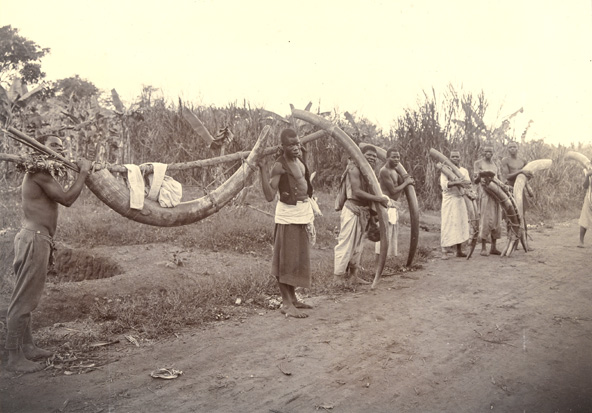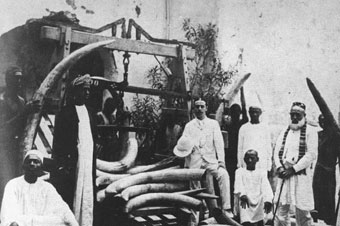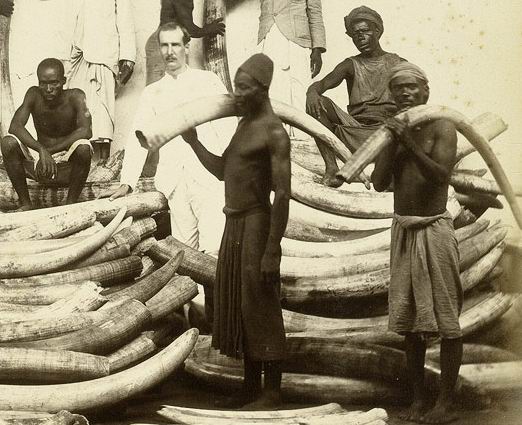In 2002, the
Hartford Courant published a well researched and beautifully written series on Connecticut's ties to slavery titled "Complicity." In Chapter Seven: "The Last Slaves Not Just Elephants Suffered And Died For Connecticut's Ivory" author Anne Farrow discusses ivory, pianos and slavery. In a field behind Deep River's historical society stands a small glass building shaped like a triangle. It looks like a greenhouse, but there is a U.S. patent for it filed by a local man named Ulysses Pratt. This "bleach house," as it was called, was designed not to grow plants but to expose to sunlight, for a period of 30 sunny days, ivory piano keys cut from the tusks of African elephants.
In Deep River and neighboring Ivoryton, a section of Essex, dozens of these bleach houses, some as long as a football field, stretched over south-facing slopes. Except for this small one, moved from several blocks away and restored to its 19th-century appearance, they are all gone. The enterprise they served, transforming ivory into piano keys, billiard balls and objects for Victorian ornament and domestic life, also is over.
In the language of historians, this glass house, which held rectangles of bleached ivory in pegged wooden racks, is an artifact.
It tells a story.
Yet nothing about this clean, modest little structure suggests that its story is steeped in the blood of a million black people.
George Washington was enjoying retirement on his farm in Virginia when Connecticut began cutting ivory. An Essex goldsmith invented a saw that could be powered by water or wind to cut the fine teeth of ivory combs. Suddenly, what had been laborious handwork was mechanized.
Two great companies rose from Phineas Pratt's small mill on the Falls River, and their evolution illuminates nearly every facet of the era's industry and commerce.
Connecticut's ivory businesses shaped elephants' teeth into the stuff and substance of 19th-century life, and brought constant innovation to the complex tasks of exporting, cutting and refining ivory. When their market expanded from baubles and combs to home entertainment - pianos and billiard balls - the ivory men kept pace. They had their era's complete and misplaced confidence in the renewability of natural resources, and the conviction that good things succeeded.
When the last remnants of Connecticut's ivory empire were sold at auction last May, there were two names on that last company: Pratt and Read.
In his portrait hanging in the Deep River Historical Society, George Read gazes mildly over his high collar at the viewer. A founder of Deep River and a deacon of his church, Read was an ardent abolitionist. He provided shelter to a black man who had fled slavery in South Carolina and settled in Deep River. The town's Winter Avenue is named for him.
Read and one of Phineas' sons dammed a section of the Deep River, built a water wheel and began cutting ivory. In 1863, midway through the Civil War, several businesses that had spun off Phineas Pratt's workshop coalesced into one - Pratt, Read & Company - which would spend the next 75 years neck-and-neck with America's other great ivory company just a short canter up the road.
Samuel Merritt Comstock.
When Samuel Merritt Comstock was born in Ivoryton in 1809 to a sea captain in the West Indies trade, the town was a crossroad with 12 houses and a different name. Comstock changed all that. He learned the ivory business in a family workshop and in the early 1860s, his solo business rapidly expanding but in need of capital, he sold a quarter-interest in his company to George A. Cheney, an ivory trader who had lived for 10 years in Zanzibar, an island off the east coast of Africa and a world trading center for ivory.
At first sight, Zanzibar was beautiful, "a gorgeous emerald laid on a velvet cloth of ocean blue," one ivory trader wrote. But the energetic New England merchants who sailed there found its blood-red flag floated above a major slave market with deep links to ivory.

Back in Connecticut, Comstock was turning West Centre Brook into an ivory-town, and one of America's first planned communities.
Donald Malcarne teaches the history and culture of the Connecticut River Valley at Wesleyan University, and is evangelical on the subject of Samuel Comstock, whom he ranks with Samuel Colt as a pioneering industrialist of the mid-19th century.
"He had a vision for the town," Malcarne says. This included not only stylish homesteads on Main Street for his executives, but houses for his middle managers, modest dwellings for the immigrant families who joined his workforce, and segregated dormitories for his young, unmarried workers. Comstock built churches (though no Catholic ones), places to shop and centers for recreation - the Wheel Club was a cycling club just for men.

Malcarne is also the town historian in Essex, and he lived this history before he taught it: "My father went to work in the ivory shop on a tiny salary," he says. And though he has produced most of the modern scholarship on Connecticut's ivory manufacturing, Malcarne isn't a company man.
He is haunted by questions about these ivory entrepreneurs who, through the industry they propelled, gave immigrants from Italy, Poland and northern Europe a foothold in America, even as they depended on the labor of hundreds of thousands of enslaved people in Africa.
On a recent gray morning, heavy rain lashing the field where a bleach house once stood, Malcarne peers mournfully through his windshield.
How, he wonders, could they not have known?
"It is simply incredible that, because ivory is required, the rich heart of Africa should be laid waste... That populations, tribes and nations should be utterly destroyed. Whom after all does this bloody seizure enrich?" - Henry M. Stanley, explorer, 1870s
The best ivory - the most durable, carveable and lustrous - is the soft ivory, actually the two front incisors, of Loxodonta africana, the African elephant. Named for the lozenge-shaped ridges on his teeth, loxodonta was plentiful in eastern and central Africa - "numerous as flies," according to one Victorian-era journalist.

The problem was getting the 80- and 100-pound tusks from the killing grounds to coastal trading centers at Mombasa, Mozambique and Zanzibar. The Europeans who later colonized Africa hadn't yet established their rail systems, and pack animals were killed in short order by the tsetse fly, the transmitter of the parasitic cattle disease trypanosomiasis.

"It is the custom to buy a tooth of ivory and a slave with it to carry it to the sea shore," wrote Michael W. Shepard, a merchant visiting Zanzibar in 1844. "Then the ivory and slaves are carried to Zanzibar and sold."
For centuries, Arab traders had plied well-established routes through the regions later made famous by Nile River explorations. Tanganyika, Kilimanjaro and the Zambesi River were new and magical names to the West but familiar to a trade world that was at least eight centuries old.

Originally from North Africa and Egypt, the traders settled throughout eastern and central Africa and maintained trading centers on Africa's great system of rivers. Cordial, accommodating and worldly, they functioned as a kind of ruling class, their influence transcending regional boundaries in a fragmented continent. They maintained cadres of armed mercenaries - Henry Stanley called them "raiders" - and controlled the flow of ivory and captive Africans.

Though famously courteous to Westerners, they were unwavering in their practice of slavery - "We must differ on these subjects but we must not quarrel," said the 19th-century's most famous trader, Hamid ibn Mohammed, to David Livingstone.

The ultimate middle men, traders like Mohammed, better known as Tippoo Tib, dominated Africa until the early 1890s, when European colonizers, decrying the continuing practice of slavery, moved in to build railroads, govern trade themselves and, they thought, end the horrors of slavery.
But at mid-19th century, the desire of an industrialized America for luxury goods dovetailed perfectly with an Africa where slavery was legal and ivory was plentiful. Connecticut entrepreneurs were as opportunistic as the moment required.

It was a system that worked for everybody, except, of course, the African tribal people. For them, it was brutal and often lethal, a system designed to exploit them even as it extracted their ivory and broke up their communities.
Their villages in flames behind them, enslaved people, often shackled together and carrying the heavy tusks, walked as far as 1,000 miles to the coast.

Many died en route. Nothing could have prepared English missionary Alfred J. Swann for the horrors of the ivory caravans he saw in Africa in the 1880s.
"... Feet and shoulders were a mass of open sores, made more painful by the swarms of flies which followed the march and lived on the flowing blood. They presented a moving picture of utter misery," he wrote, noting also that they were covered with the scars of the chikote, a leather whip.

In his account of exploring the Zambesi River in southeastern Africa in 1858, Livingstone, who recorded his observations with the evocative detail of a novelist, came upon another group of these refugees.
"... A long line of manacled men, women and children, came wending their way round the hill and into the valley, on the side of which the village stood. The black drivers, armed with muskets and bedecked with various articles of finery, marched jauntily in the front, middle, and rear of the line; some of them blowing exultant notes out of long horns."

The guards fled when they saw Livingstone and his men, and the explorer freed the Africans. "Knives were soon busy at work cutting the women and children loose. It was more difficult to cut the men adrift, as each had his neck in the fork of a stout stick, six or seven feet long, and kept in by an iron rod which was riveted at both ends across the throat."

Africa scholars say that as pressure from the American and European ivory markets intensified, so did the misery among Africans forced into porterage.
The suffering that accompanied ivory fills a half-century of eyewitness accounts, from the 1830s to the 1880s, decades when America at home was moving decisively against slavery. The Civil War ended slave labor here, but it did not end the idea that black people were inferior and inherently suited to physical labor, that they were made for exploitation and did not mind.

Hard at work was what one historian calls "the bifurcated mind" of 19th-century commerce: Slavery wasn't a problem; the sight of it was.
If you were involved in the Africa trade, you saw it.

John Bertram was a staggeringly successful Massachusetts trader (and later, a philanthropist) from whom Samuel Comstock bought ivory. In 1843, a young buyer who worked for Bertram detailed a trip to a coastal city not far from Mozambique, where he and his partner sold New England cottons and muskets and bought goods from African traders.
"We also purchased a quantity of fine Ivory, sea horse [hippopotamus] tusk & tortoise shell from them. I here assisted Capt Bates in the `store' and after hours we used to walk out among the cocoa nut trees. There I saw several times gangs of Slaves just as they came in from the interior of Africa, thin almost as Skeletons. They had an iron ring round the neck & a chain went through it, thus connecting 40 or 50 in a line ..."
Livingstone said that it was almost impossible to write about the slave trade in East Africa without being accused of exaggeration, because the truth was so horrific.
He had come to Africa as a medical missionary in 1840. A natural explorer and geographer, he became convinced that Africa's lakes and rivers could be used as highways for commerce and thus end the slave trade. He spent the rest of his life exploring these rivers and documenting what he saw.
Livingstone became, along the way, the slave trade's most famous witness. In June 1868, he wrote, "Six men slaves were singing as if they did not feel the weight and degradation of the slave-sticks. I asked the cause of their mirth, and was told they rejoiced at the idea `of coming back after death, and haunting and killing those who had sold them.'"
The chorus of their song was the names of the men who had sold them.
"The man of civilization condemns with indignation the barbarisms of the Arab slaver, but let the white man pause and think for one moment and he will realize how deeply he himself is implicated ... Who is the purchaser of the costly elephant tusk?"

- E.J. Glave, correspondent, 1896
Piano keys were once made of rare woods, but by the late 1830s, ivory was found to be the ideal substance for the veneer of the keys. Cool and smooth to the touch, never sticky or slippery yet offering a slight resistance to the fingers, ivory was also beautiful.

The keys within a single keyboard were always cut from the ivory of a single tusk, because close matching of grain and color was important. A good-sized tusk yielded the wafer-thin veneer for 45 keyboards. Billiard balls were always made from the tusks of female elephants, because their tusks were straighter, and a nerve that ran down the center of the tusk caused a ball, when correctly fashioned, to roll true. A female tusk of average size yielded five billiard balls. The old sales documents often refer to the ivory of female elephants, simply, as "billiard."

Much of the complex technology for cutting perfectly matched keyboards and applying the ivory veneer was developed in Connecticut, and in 1851, when a Chickering piano took first prize at the Crystal Palace Exhibition in London, the demand for pianos of American manufacture was immediate and dramatic. (That trend-setting piano almost certainly had a keyboard made in Deep River, because Pratt was the major supplier for the Boston piano maker.)

A piano in the parlor became the single most potent symbol of the cultured home. Its presence suggested refinement, an appreciation for music, and that the household recognized entertainment as, correctly, centered in the home. (In her 1869 bestseller "American Woman's Home," Hartford's Catharine Beecher commented, with her usual tartness, that although music was a "very elevating" recreation for the young, she "would protest against the practice common in many families, of having the daughters learn to play on the piano whether they have a taste and an ear for music, or not.")
Everything was in place: An increasingly industrialized America had the money for luxury goods like pianos, the desire to own them and the know-how of her Yankee ivory-cutters, who by the 1840s were cutting more than a ton of ivory every week. Depending on the weight of the tusks, and at that time an 80-pound tusk was a good average, at least a dozen elephants a week were dying to fuel Connecticut's factories. And the heyday of the industry - a heyday that lasted 50 years - was still to come.

In retrospect, the disparate skeins of history come together as if perfectly woven.
On the other side of the world, in what seems like a diabolical coincidence, the world market for cloves, a spice grown on islands off the east coast of Africa, exploded.
Many of the enslaved Africans who managed to survive the trek to the eastern coast wound up in the slave market in Zanzibar. From there, they were sold into forced labor on clove plantations on Pemba and Zanzibar and other Indian Ocean islands, or on huge sugar plantations in Brazil, where slavery was legal until 1888. They were also sold into agricultural slavery in Arabia and North Africa. (The United States banned the forced importation of human beings in 1808, so ivory's porters did not end up as slaves in this country.)
America's first consul in Zanzibar described the frenetic life onshore, with its constant deal-making and politicking, and offshore, where ships from New England and Europe were stacked up like planes at O'Hare airport, waiting to ferry Africa's riches to the outer world.
"In the morning a Dhow arrived from Zanzibar," wrote Richard Waters, then in Mozambique. "In the afternoon two Slavers, a Brig and Schooner. This city is a depot for slave Vessels, which collect Slaves on the coast, at different places. I can see from the deck of our Vessel that the decks of these Slavers are filled with Slaves, mostly with children, from 10 to 14 years of age. This sight called up many unpleasant feelings. What can I say to those engaged in this trade, when I remember the millions of Slaves which exist in my own country?"

When Waters confided guilt feelings to his journal in 1837, there were 2 million enslaved people in America - a figure that doubled before the Civil War. He was, like Connecticut ivory men Julius Pratt and George Read, active in the anti-slavery movement. But he was in Zanzibar to promote trade relations with East Africa, and to help build a market that would make New Englanders rich. Waters' feelings may have been conflicted, but his mission was clear.
The rest of the 19th century would show there was a great difference between the horror of slavery in America and the lives of faraway Africans, whose suffering could not be imagined. And was not.
"A continent ages quickly once we come to it."- Ernest Hemingway, "The Green Hills of Africa," 1934
If you stand in front of the trim, red-brick Pratt, Read factory built in 1882 (replacing a wooden structure destroyed by fire on a July Sunday in 1881), you can look across to the side street where ivory tusks were brought up from the river landing in horse-drawn wagons. The factory, now a condominium complex called The Piano Works, overshadows Deep River's main street.
Though Deep River was never a company town like Sam Comstock's Ivoryton - Deep River had shipbuilding and quarrying among other enterprises - Pratt, Read was the major employer and the center of town life. When fire destroyed the factory proper, 15 tons of ivory and everything but the company safe, about 150 men were on the payroll. At a meeting held days later, townspeople voted to offer the company a major tax abatement to rebuild in Deep River.

Contemporary accounts of Pratt, Read and competitor Comstock, Cheney lauded the company leaders for the rigor of their work ethic and their "native Yankee shrewdness." They weren't wrong. To a raw material brought from halfway around the world, the ivory workers applied artisan-level craftsmanship and precision machine work. This was the new American style of industry, and the result was a high-volume, high-quality product that brought the two companies contracts from throughout the country.
Correspondence from the early summer of 1876, for example, shows Comstock, Cheney supplying ivory to more than a dozen piano and organ manufacturers, not to mention companies that made billiard tables and other ivory objects.
For more than a century, Connecticut was a center of ivory knowledge, the center of ivory manufacturing in America and a world leader in the business. Of the thousands of tons of ivory that passed through Zanzibar during the 19th and early 20th centuries, 75 percent of the total came to Connecticut.
Smithsonian curator David Shayt, who has extensively researched Connecticut's ivory industry, estimates that between 1884 and 1911, nearly 10 million pounds of unworked ivory were brought into the United States. The per-pound price on the New York market ranged from $1.80 to $4. That's a minimum figure of nearly $18 million - or about $310 million in today's currency.
That's a lot of money, and a lot of elephants, and a lot of black people carrying ivory to a port called Bagamoyo, which means, in Swahili, lay down the burden of your heart.

"Ivory! Always Ivory! What a curse the elephant has been to Africans!"
- Albert J. Swann, The London Missionary Society, 1888
A brochure produced by a German ivory company for the 1876 Centennial Exhibition in Philadelphia notes that most of the ivory harvested from Africa was just lying on the ground. In fact, early in that century great caches of available ivory had been assembled through trade with individual villages.
Africa may have been the only place ivory tusks ever served utilitarian purposes. They were used for animal stockades, door posts and roof beams, and carved into the tools of daily life, such as mortars and pestles. Explorer Henry Stanley also saw tusks surrounding the gravesites of chieftains. The elephant was food, and for some tribal people the elephant had a spiritual dimension and was represented in their art. African peoples' reliance on the elephant for purposes other than decorative was interpreted by the West as hard evidence of their ignorance. But Africa didn't decimate the elephant, America did.
By the time of the centennial, the notion of piles of ivory waiting to be scooped up was a convenient, tragic fiction.
The Smithsonian's National Museum of American History contains a chilling collection of correspondence from McLean, Morris & Company, the London broker from whom Comstock, Cheney bought huge quantities of tusks during the 1870s.
The handwritten letters, each still bearing its small circle of red sealing wax, detail with brutal clarity the amounts and varieties of ivory coming to market - "Zanzibar Prime" was the very best - as well as news of sales trends and anticipated shipments. McLean, Morris' cheerful communiques to Ivoryton - several times a week - and the printed circulars show annual sales of hundreds of tons of ivory. The German firm of Heinrich Adolf Meyer, a competitor of the Connecticut ivory companies, estimated that 2 million pounds of ivory were "consumed" each year worldwide.
At mid-century, English explorers had seen great herds of elephants. Livingstone once counted a group of 800, but by the 1870s, the devastating effect of all those pianos was apparent. Ivory buyers in London and New York noticed a decline in the amount of ivory coming to market. (Pratt, Read began experimenting with keys made from celluloid, but the market wanted ivory.)
As elephant populations in East Africa dwindled and ivory was harvested from slaughtered elephants in Central and West Central Africa, the journey to the coast got longer and harder for ivory's human porters. Explorers like Stanley saw a devastated landscape of burned and empty villages. An entire frontier of ivory-taking and human enslavement was moving west.
Under the weight of the tusks they were forced to carry, men and women taken from their villages by force walked hundreds of miles to the coast from inland trading centers on the Congo River and Lake Tanganyika, among other places. Ujiji, the ivory and slave trading center on the northeastern shore of Lake Tanganyika where Stanley famously encountered Dr. Livingstone, was 700 miles from the coast, but the trek was often even longer than that.
The horrors of the ivory trade were not the temporary depredations of war or civil strife but were part of an ongoing system, one that lasted for at least 80 years and used black human beings as commercial currency.
Echoing accounts of the 1830s and '40s, a Scottish theologian who had followed in Livingstone's footsteps wrote in 1888, "The slaves are needed to buy the ivory with; then more slaves must be stolen to carry it ... Like a river, a slave caravan has to be fed by innumerable tributaries along its course - at first in order to gather a sufficient volume of human bodies for the start, and afterwards to replace the frightful loss by desertion, disablement and death."

Some of the most sustained and harrowing descriptions of the ivory trade come from a Connecticut man who was an ivory trader himself, and a very good one.
Ernst D. Moore was 23 when his uncle brought him into the family ivory business. From 1907 to 1911, Moore was based primarily in Zanzibar, buying elephant tusks in the market and traveling to the interior of Africa, where he bought directly from great hunters of the day for Arnold Cheney & Co., which supplied both Pratt, Read and Comstock, Cheney.
He lived in a house with carved teakwood gates, entertained Teddy Roosevelt at the Mombasa Club, bought hundreds of tons of ivory, and then came home to marry a woman in Chester and work for Pratt, Read as an executive in the company's player piano division. An able pianist, he loved to play Liszt, recalls his son Richard, now in his 80s.
Ernst Moore wrote a book called "Ivory, Scourge of Africa." Published in 1931, it is a history of the ivory trade and a cult classic. The original cover for the book - an account The New York Herald called "magnificent" and "hair-raising" - shows the slave coffle, the term for a line of ivory-bearing black people linked together by roughly carved wooden forks, the "V" of the fork enclosing the neck of each.
During the second half of the 19th century, the height of the ivory trade, Moore wrote, "the dhows that lay at anchor off the town were packed with slaves awaiting transport to Arabia and the Gulf. Slaves lay on the sloping beach, dead slaves, not worth the burying, thrown there to rot until the tide carried their bloated bodies out to sea."
Moore described the ivory gathering of the 19th century as carnage. Contemporary historian Malcarne, who is careful about what he calls "cultural relevancy" and the dangers inherent in judging the past by standards of the present, uses the same word.
Although slavery was outlawed in East Africa in the decade before Moore began his career, and the railroads built by England and Germany carried ivory directly from the interior to the coast, human porterage and oppression continued.
A world campaign against slavery in Africa had been mounted during the decades after the American Civil War, "But that indignation did not always extend to centers of slavery," says a Nigerian history professor who is assembling a database on captives rescued from slave ships from West Africa. Traders did not want to let go of a lucrative system that had worked for so long, and the priority of the West was to maintain the flow of ivory. Tens of thousands of Americans were buying pianos every year, and pianos required ivory.
"The 19th century was the high point of racist thought," says G. Ugo Nwokeji, a history professor at the University of Connecticut. "Africa was seen as an unredeemable backwater, a primitive place, its cultures stagnant."
The social chaos and enslavement that followed the ivory trade was, for the West, the cost of doing business.
"Hey, `Darkest Africa,'" Nwokeji says, shaking his head.
"When [the slaves] arrive in Zanzibar they are discharged in the same manner as a load of sheep would be, the dead ones thrown overboard to drift down with the tide and if in their course they strike the beach and ground, the natives come with pole and push them from the beach ..."
- Michael W. Shepard, 1844
From "New England Merchants in Africa"
A measure of the inseparability of the ivory trade and the slave trade is contained in the way the human deaths are counted. It was an equation first formulated by Livingstone, and one modern historians use as well: Five black people were killed or forced into slavery for each elephant tusk that reached the coast. Henry Stanley's number is higher: He says that for each pound of ivory, someone died.
Malcarne looks bleak when these figures come up.
Working from the company records, he estimates that between 1870 and 1900, at least 200,000 tusks were used by Comstock, Cheney. If every tusk represents the death or enslavement of five people, then the Ivoryton company affected 1 million Africans. Bring Pratt, Read into the equation - and during the last decade of the 19th century the Deep River company actually handled more ivory than Comstock, Cheney - and the estimate becomes 2 million lives affected.
These numbers lead historians to the lives of Connecticut's ivory entrepreneurs. What did they know and when did they know it? "George Cheney was in Zanzibar for 10 years," Malcarne says, covering the sides of his eyes as if to suggest blinders.
Even Nile explorer Richard Burton, who was notorious for his prejudices against Africans, describes the market - the same marketplace Cheney would have seen - in terms of dread: "Lines of negroes stood like beasts ... all were horribly thin, with ribs protruding like the circles of a cask, and not a few were sick on the ground ..." Men and women of all ages were subjected to a "degrading and hardly decent inspection."
"The purchaser walks up to one he likes the look of and throws a stick at some distance and tells the slave to pick it up. By this he has a chance to see his gait or if there is any lameness," Salem trader Shepherd wrote in his ship's log.
Between the 1790s of Phineas Pratt and the late-Victorian era of George Cheney 80 years later, America's relationship with slavery at home changed dramatically, but the ivory cutters' contract with Africa did not change. Ivory was good for Connecticut, which, by then, was home to 90 percent of America's ivory manufacturing.
Even to mid-century ivory men like abolitionists George Read and Julius Pratt, the shameful reality of slavery in America was distinct from the human rights of Africans.
They would not have seen their beliefs and their work as contradictory because they understood the end of slavery as a national problem. They were, to reverse the popular expression, acting globally but thinking locally.
The most pressing concern facing ivory's entrepreneurs would have been how to make their complex industry succeed, says Yale historian Jennifer Baszile. So many indispensable products at the time were produced by slave labor, cotton and sugar to name just two, "By the 1850s, Americans in Connecticut were involved in slavery in ways they couldn't fully draw out," Baszile says.
The modern image of an abolitionist is Bostonian William Lloyd Garrison: uncompromising, passionately committed to the human rights of black people everywhere and willing to undergo any risk in the service of his beliefs. He promised in the first edition of his anti-slavery newspaper to be "as harsh as truth," and he was. Yet the Garrisonian abolitionist represented only a small percentage of those involved in the movement, though, admittedly, that small group was noisy and influential.
Many Connecticut abolitionists sought an end to slavery in the South because, among other reasons, it conflicted with their notions of a free republic, a free America.
Yet, Baszile says, "They continued to profit from slavery at the same time that slavery was `over' [in America]."
But the war that was fought to end slavery in America, the war that made slavery "over," brought with it a new and disabling reality, one with a ripple that reached Africa.
The casualties of the war were so high and communities so devastated - of the 54,882 Connecticut soldiers who served, 20 percent died of disease or injuries or were wounded - that the nation's priority became the reconciliation of North and South. A bomb went off in America, and it killed 620,000 men. Scholars say that the real post-war agenda, which should have been to create a place in society for millions of freed black Southerners, most of whom were illiterate and impoverished, was not addressed. America had to heal first.

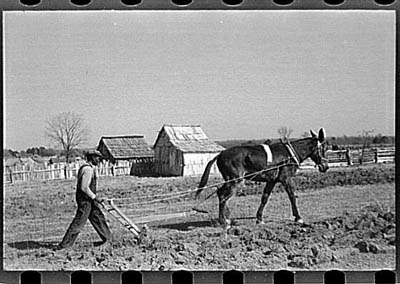







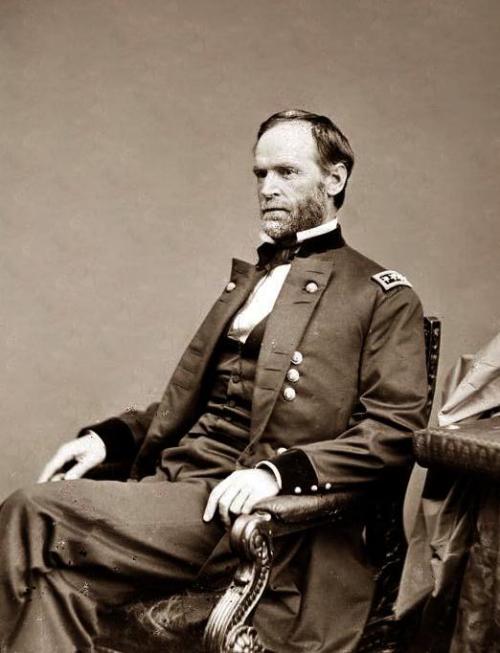










 The problem was getting the 80- and 100-pound tusks from the killing grounds to coastal trading centers at Mombasa, Mozambique and Zanzibar. The Europeans who later colonized Africa hadn't yet established their rail systems, and pack animals were killed in short order by the tsetse fly, the transmitter of the parasitic cattle disease trypanosomiasis.
The problem was getting the 80- and 100-pound tusks from the killing grounds to coastal trading centers at Mombasa, Mozambique and Zanzibar. The Europeans who later colonized Africa hadn't yet established their rail systems, and pack animals were killed in short order by the tsetse fly, the transmitter of the parasitic cattle disease trypanosomiasis.

 Though famously courteous to Westerners, they were unwavering in their practice of slavery - "We must differ on these subjects but we must not quarrel," said the 19th-century's most famous trader, Hamid ibn Mohammed, to David Livingstone.
Though famously courteous to Westerners, they were unwavering in their practice of slavery - "We must differ on these subjects but we must not quarrel," said the 19th-century's most famous trader, Hamid ibn Mohammed, to David Livingstone.












 In retrospect, the disparate skeins of history come together as if perfectly woven.
In retrospect, the disparate skeins of history come together as if perfectly woven. When Waters confided guilt feelings to his journal in 1837, there were 2 million enslaved people in America - a figure that doubled before the Civil War. He was, like Connecticut ivory men Julius Pratt and George Read, active in the anti-slavery movement. But he was in Zanzibar to promote trade relations with East Africa, and to help build a market that would make New Englanders rich. Waters' feelings may have been conflicted, but his mission was clear.
When Waters confided guilt feelings to his journal in 1837, there were 2 million enslaved people in America - a figure that doubled before the Civil War. He was, like Connecticut ivory men Julius Pratt and George Read, active in the anti-slavery movement. But he was in Zanzibar to promote trade relations with East Africa, and to help build a market that would make New Englanders rich. Waters' feelings may have been conflicted, but his mission was clear. Contemporary accounts of Pratt, Read and competitor Comstock, Cheney lauded the company leaders for the rigor of their work ethic and their "native Yankee shrewdness." They weren't wrong. To a raw material brought from halfway around the world, the ivory workers applied artisan-level craftsmanship and precision machine work. This was the new American style of industry, and the result was a high-volume, high-quality product that brought the two companies contracts from throughout the country.
Contemporary accounts of Pratt, Read and competitor Comstock, Cheney lauded the company leaders for the rigor of their work ethic and their "native Yankee shrewdness." They weren't wrong. To a raw material brought from halfway around the world, the ivory workers applied artisan-level craftsmanship and precision machine work. This was the new American style of industry, and the result was a high-volume, high-quality product that brought the two companies contracts from throughout the country.  "Ivory! Always Ivory! What a curse the elephant has been to Africans!"
"Ivory! Always Ivory! What a curse the elephant has been to Africans!"





